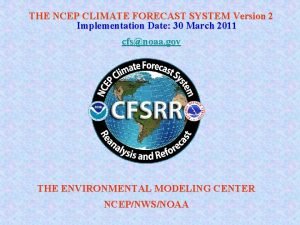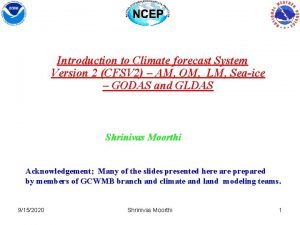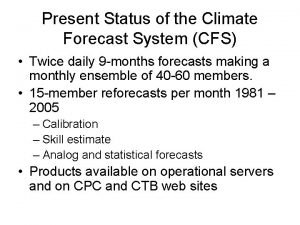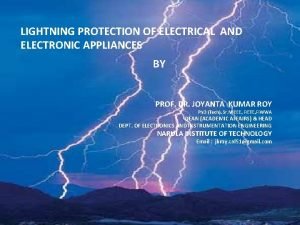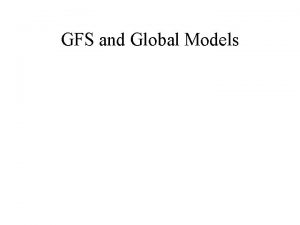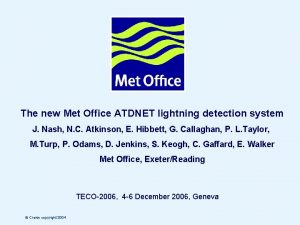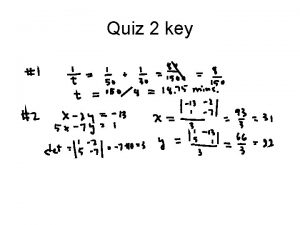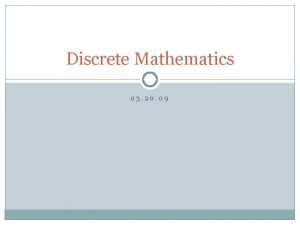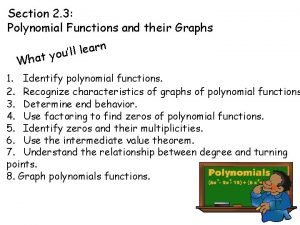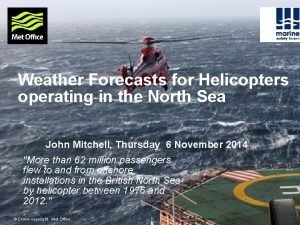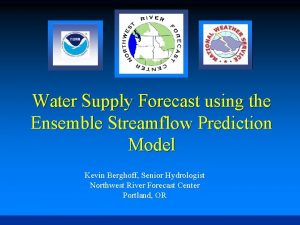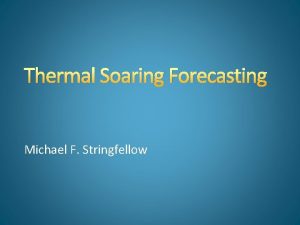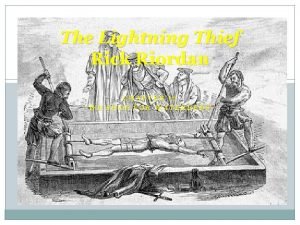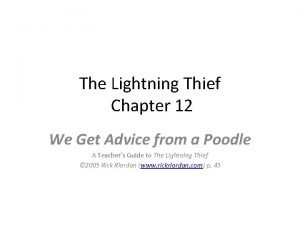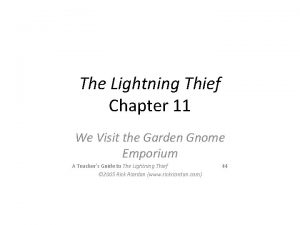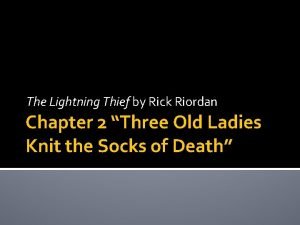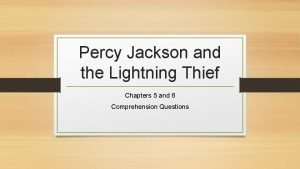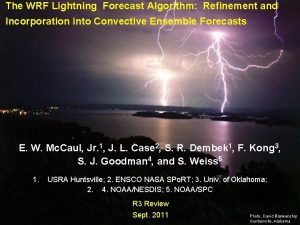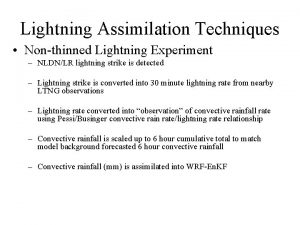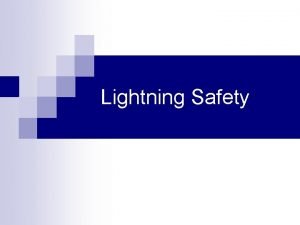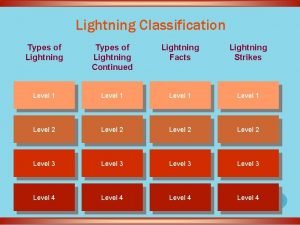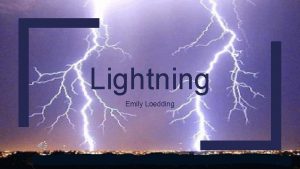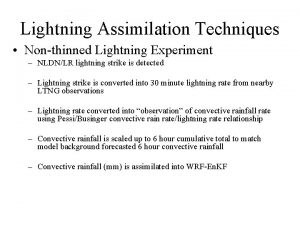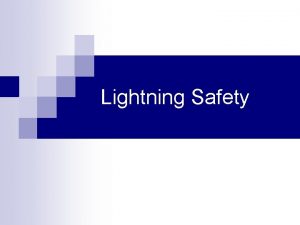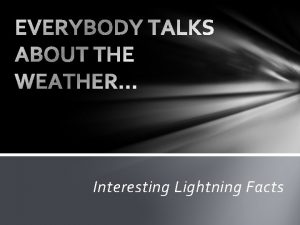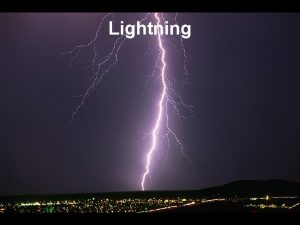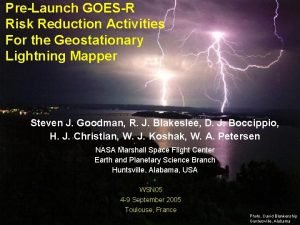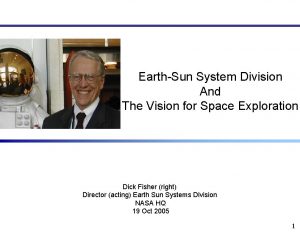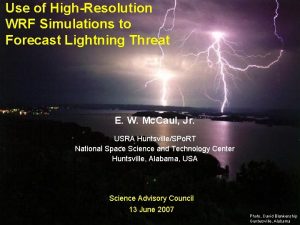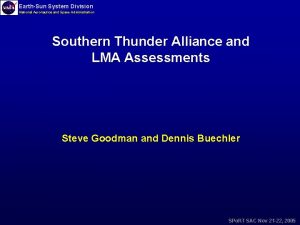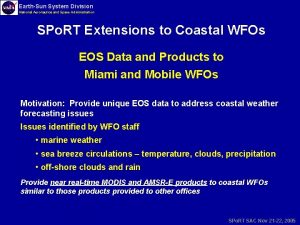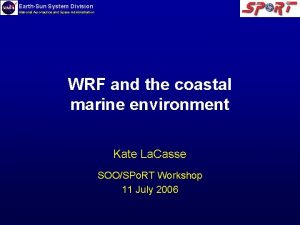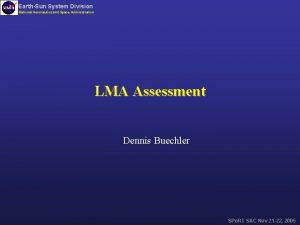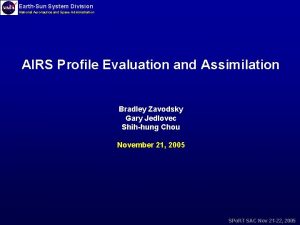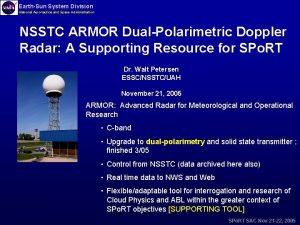EarthSun System Division Lightning Forecast Algorithm R 3































- Slides: 31

Earth-Sun System Division Lightning Forecast Algorithm (R 3) National Aeronautics and Space Administration E. W. Mc. Caul, Jr. USRA Huntsville 6/13/2021 High Impact WW Feb 24, 2011 1 High Photo, David Blankenship Impact WW, Feb 2011 Guntersville, Alabama

Earth-Sun System Division National Aeronautics and Space Administration Comparison of coverage: CAPE vs LFA Threat 1 6/13/2021 2 High Impact WW, Feb 2011

Earth-Sun System Division National Aeronautics and Space Administration Objectives Given LTG link to large ice, and a good CRM like WRF, we seek to: 1. Create WRF forecasts of LTG threat (1 -24 h), based on 2. simple proxy fields from explicitly simulated convection: 3. - graupel flux near -15 C (captures LTG time variability) 4. - vertically integrated ice (captures anvil LTG area) 2. Construct a calibrated threat that yields accurate quantitative peak flash rate densities for the strongest storms, based on LMA total LTG data 3. 3. Test algorithm over CONUS to assess robustness 6/13/2021 for use in making proxy LTG data, potential uses with 3 High Impact WW, Feb 2011

Earth-Sun System Division National Aeronautics and Space Administration WRF Lightning Threat Forecasts: Methodology 1. Use high-resolution 2 -km WRF simulations to prognose 2. convection for a diverse series of selected case studies 2. Evaluate two proxy fields: graupel fluxes at -15 C level; vertically integrated ice (VII=cloud ice+snow+graupel) 3. Calibrate these proxies using peak total LTG flash rate densities from NALMA vs. strongest simulated storms; relationships ~linear; regression line passes through origin 4. 4. Truncate low threat values to make threat areal coverage match NALMA flash extent density obs 5. Blend proxies to achieve optimal performance 6. 6. Study NSSL 4 -km, CAPS 4 -km CONUS ensembles to evaluate performance, assess robustness 6/13/2021 4 High Impact WW, Feb 2011

Earth-Sun System Division National Aeronautics and Space Administration WRF Lightning Threat Forecasts: Methodology 1. Regression results for threat 1 “F 1” (based on graupel flux FLX = w*qg at T=-15 C): 2. F 1 = 0. 042*FLX (require F 1 > 0. 01 fl/km 2/5 min) 2. Regression results for threat 2 “F 2” (based on VII, which uses cloud ice + snow + graupel from WRF WSM-6): 3. F 2 = 0. 2*VII (require F 2 > 0. 4 fl/km 2/5 min) 6/13/2021 5 High Impact WW, Feb 2011

Earth-Sun System Division National Aeronautics and Space Administration Calibration Curve Threat 1 (Graupel flux) F 1 = 0. 042 FLX F 1 > 0. 01 fl/5 min r = 0. 67 6/13/2021 6 High Impact WW, Feb 2011

Earth-Sun System Division National Aeronautics and Space Administration Calibration Curve Threat 2 (VII) F 2 = 0. 2 VII F 2 > 0. 4 fl/5 min r = 0. 83 6/13/2021 7 High Impact WW, Feb 2011

Earth-Sun System Division National Aeronautics and Space Administration LTG Threat Methodology: Advantages • Methods based on LTG physics; should be robust and regime-independent • Can provide quantitative estimates of flash rate fields; use of thresholds allows for accurate threat areal coverage • Methods are fast and simple; based on fundamental model output fields; no need for complex electrification modules 6/13/2021 8 High Impact WW, Feb 2011

Earth-Sun System Division National Aeronautics and Space Administration LTG Threat Methodology: Disadvantages • Methods are only as good as the numerical model output; models usually do not make storms in the right place at the right time; saves at 15 min sometimes miss LTG jump peaks • Small number of cases, lack of extreme LTG events means uncertainty in calibrations • Calibrations should be redone whenever model is changed (see example next page; pending studies of sensitivity to grid mesh, model microphysics, to be addressed here) 6/13/2021 9 High Impact WW, Feb 2011

Earth-Sun System Division National Aeronautics and Space Administration WRF Configuration (typical) 30 March 2002 Case Study • 2 -km horizontal grid mesh • 51 vertical sigma levels • Dynamics and physics: – – – 6/13/2021 Eulerian mass core Dudhia SW radiation RRTM LW radiation YSU PBL scheme Noah LSM WSM 6 -class microphysics scheme (graupel; no hail) • 8 h forecast initialized at 00 UTC 30 March 2002 with AWIP 212 NCEP EDAS analysis; • Also used METAR, ACARS, and WSR 88 D radial vel at 00 UTC; • Eta 3 -h forecasts used for LBC’s 10 High Impact WW, Feb 2011

Earth-Sun System Division National Aeronautics and Space Administration WRF Lightning Threat Forecasts: Case: 30 March 2002 Squall Line plus Isolated Supercell 6/13/2021 11 High Impact WW, Feb 2011

Earth-Sun System Division National Aeronautics and Space Administration WRF Sounding, 2002033003 Z Lat=34. 4 Lon=-88. 1 CAPE~2800 6/13/2021 12 High Impact WW, Feb 2011

Earth-Sun System Division National Aeronautics and Space Administration Ground truth: LTG flash extent density + d. BZ 30 March 2002, 04 Z 6/13/2021 13 High Impact WW, Feb 2011

Earth-Sun System Division National Aeronautics and Space Administration WRF forecast: LTG Threat 1 + 6 km d. BZ 30 March 2002, 04 Z 6/13/2021 14 High Impact WW, Feb 2011

Earth-Sun System Division National Aeronautics and Space Administration WRF forecast: LTG Threat 2 + 10 km anvil ice 30 March 2002, 04 Z 6/13/2021 15 High Impact WW, Feb 2011

Earth-Sun System Division National Aeronautics and Space Administration Implications of results: 1. WRF LTG threat 1 coverage too small (updrafts emphasized) 2. WRF LTG threat 1 peak values have adequate t variability 3. WRF LTG threat 2 peak values have insufficient t variability (because of smoothing effect of z integration) 4. WRF LTG threat 2 coverage is good (anvil ice included) 5. WRF LTG threat mean biases can exist because our method of calibrating was designed to capture peak flash rates, not mean flash rates 6. Blend of WRF LTG threats 1 and 2 should offer good time variability, good areal coverage 6/13/2021 16 High Impact WW, Feb 2011

Earth-Sun System Division National Aeronautics and Space Administration Construction of blended threat: 1. Threat 1 and 2 are both calibrated to yield correct peak flash densities 2. The peaks of threats 1 and 2 also tend to be coincident in all simulated storms, but threat 2 covers more area 3. Thus, weighted linear combinations of the 2 threats will also yield the correct peak flash densities 4. To preserve most of time variability in threat 1, use large weight w 1 5. To preserve areal coverage from threat 2, avoid very small weight w 2 6. Tests using 0. 95 for w 1, 0. 05 for w 2, yield satisfactory results 6/13/2021 17 High Impact WW, Feb 2011

Earth-Sun System Division National Aeronautics and Space Administration Blended Threat 3 + d. BZ: 2002033004 Z 6/13/2021 18 High Impact WW, Feb 2011

Earth-Sun System Division National Aeronautics and Space Administration General Findings: 1. LTG threats 1 and 2 yield reasonable peak flash rates 2. LTG threats provide more realistic spatial coverage of LTG than that suggested by coverage of positive CAPE, which overpredicts threat area, especially in summer - in AL cases, CAPE coverage ~60% at any t, but our LFA, NALMA obs show storm coverage only ~15% - in summer in AL, CAPE coverage almost 100%, but storm time-integrated coverage only ~10 -30% - in frontal cases in AL, CAPE coverage 88 -100%, but squall line storm time-integrated coverage is 50 -80% 3. Blended threat retains proper peak flash rate densities, because constituents are calibrated and coincident 4. Blended threat retains temporal variability of LTG threat 1, and offers proper areal coverage, thanks to threat 2 6/13/2021 19 High Impact WW, Feb 2011

Earth-Sun System Division National Aeronautics and Space Administration Ensemble studies, CAPS cases, 2008: (examined to test robustness under varying grids, physics) 1. Examined CAPS ensemble output for two AL-area storm events from Spring 2008: 2 May and 11 May 2. NALMA data examined for both cases to check LFA 3. Caveats based on data limitations: - CAPS grid mesh 4 km, whereas LFA trained on 2 km mesh - model output saved only hourly; no peak threats available - to check calibrations, use mean of 12 NALMA 5 -min peaks 4. Results from 10 CAPS ensemble members, 2 cases: - Threat 1 always smaller than Threat 2, usually 10 -20% - Threat 2 values look reasonable compared to NALMA - Threat 1 shows more sensitivity to grid change than Threat 2 6/13/2021 20 High Impact WW, Feb 2011

Earth-Sun System Division National Aeronautics and Space Administration CAPS p 2, Threat 1: 2008050300 Z (Member p 2 chosen for its resemblance to original WRF configuration) 6/13/2021 21 High Impact WW, Feb 2011

Earth-Sun System Division National Aeronautics and Space Administration CAPS p 2, Threat 2: 2008050300 Z (Note greater amplitude and coverage of Threat 2 vs. Threat 1) 6/13/2021 22 High Impact WW, Feb 2011

Earth-Sun System Division National Aeronautics and Space Administration Ensemble findings (preliminary): 1. Tested LFA on two CAPS 2008 4 km WRF runs 2. Two cases yield consistent, similar results 3. Results sensitive to coarser grid mesh, model physics - Threat 1 too small, more sensitive (grid mesh sensitivity? ) - Threat 2 appears less sensitive to model changes - Remedy: boost Threat 1 to equal Threat 2 peak values before creating blended Threat 3 4. Implemented modified LFA in NSSL WRF 4 km runs in 2010 6/13/2021 23 High Impact WW, Feb 2011

Earth-Sun System Division National Aeronautics and Space Administration 2010 work with NSSL WRF: 1. LFA now used routinely on NSSL WRF 30 -h runs 2. See www. nssl. noaa. gov/wrf and look for Threat plots 3. Results are expressed in terms of hourly gridded maxima for threats 1, 2, before rescaling of threat 1; units are flashes per sq. km per 5 min 4. To make blended threat 3, we use fields of hourly maxima of threats 1, 2, after appropriate rescaling of threat 1 5. Potential issues: in snow events, can have spurious threat 2; in extreme storms, threat 2 fails to keep up with threat 1, even though coarser grid argues for need to boost threat 1; further study needed 6. NSSL collaborators, led by Jack Kain, tested LFA reliability against existing LTG forecast tools, with favorable findings 6/13/2021 24 High Impact WW, Feb 2011

Earth-Sun System Division National Aeronautics and Space Administration Sample of NSSL WRF output, 20101130 (see www. nssl. noaa. gov/wrf) 6/13/2021 25 High Impact WW, Feb 2011

Earth-Sun System Division National Aeronautics and Space Administration NSSL WRF data: 24 April 2010 6/13/2021 26 High Impact WW, Feb 2011

Earth-Sun System Division National Aeronautics and Space Administration NSSL WRF data: 25 April 2010 6/13/2021 27 High Impact WW, Feb 2011

Earth-Sun System Division National Aeronautics and Space Administration NSSL WRF output: 17 July 2010 6/13/2021 28 High Impact WW, Feb 2011

Earth-Sun System Division National Aeronautics and Space Administration Scatterplot of selected NSSL WRF output for threats 1, 2 (internal consistency check) 6/13/2021 Threats 1, 2 should cluster along diagonal; deviation at high flash rates indicates need for recalibration 29 High Impact WW, Feb 2011

Earth-Sun System Division National Aeronautics and Space Administration Future Work: 1. Examine more simulation cases from 2010 Spring Expt; test LFA against dry summer LTG storms in w USA 2. Compile list of intense storm cases, and use NALMA, OKLMA data to recheck calibration curves for nonlinear effects; test for sensitivity to additional storm parameters 3. Run LFA in CAPS 2011 ensembles, assess performance; - evaluate LFA in other configurations of WRF ARW - more hydrometeor species - double-moment microphysics 4. LFA threat fields may offer opportunities for devising data assimilation strategies based on observed total LTG, from both ground-based and satellite systems (GLM) 6/13/2021 30 High Impact WW, Feb 2011

Earth-Sun System Division National Aeronautics and Space Administration Acknowledgments: This research was funded by the NASA Science Mission Directorate’s Earth Science Division in support of the Short-term Prediction and Research Transition (SPo. RT) project at Marshall Space Flight Center, Huntsville, AL. Thanks to collaborators Steve Goodman, NOAA, and K. La. Casse and D. Cecil, UAH, who helped with the recent W&F paper (June 2009). Thanks to Gary Jedlovec, Rich Blakeslee, Bill Koshak (NASA), and Jon Case (ENSCO) for ongoing support for this research. Thanks also to Paul Krehbiel, NMT, Bill Koshak, NASA, Walt Petersen, NASA, for helpful discussions. For published paper, see: Mc. Caul, E. W. , Jr. , S. J. Goodman, K. La. Casse and D. Cecil, 2009: Forecasting lightning threat using cloud-resolving model simulations. Wea. Forecasting, 24, 709 -729. 6/13/2021 31 High Impact WW, Feb 2011
 Climate forecast system version 2
Climate forecast system version 2 Cfsv
Cfsv Reforecast past tense
Reforecast past tense External lightning protection system
External lightning protection system Global forecast system
Global forecast system Atdnet sports
Atdnet sports Long division and short division
Long division and short division Aynthetic division
Aynthetic division Repeated subtraction method
Repeated subtraction method Synthetic division examples with answers
Synthetic division examples with answers Floating point division algorithm in computer architecture
Floating point division algorithm in computer architecture Euclidean algorithm for polynomials calculator
Euclidean algorithm for polynomials calculator Standard algorithm division
Standard algorithm division Divisibility and division algorithm in cryptography
Divisibility and division algorithm in cryptography Division algorithm in discrete mathematics
Division algorithm in discrete mathematics What is division algorithm
What is division algorithm Difference between a* and ao*
Difference between a* and ao* Sweep line codeforces
Sweep line codeforces Fhsaa lightning policy
Fhsaa lightning policy Helicopter weather forecast
Helicopter weather forecast The air generally becomes drier when brainpop
The air generally becomes drier when brainpop Nwrfc water supply
Nwrfc water supply Soaring forecast
Soaring forecast Percy jackson chapter 17
Percy jackson chapter 17 Chapter 12 percy jackson the lightning thief
Chapter 12 percy jackson the lightning thief Percy jackson chapter 11 pdf
Percy jackson chapter 11 pdf Percy jackson the lightning thief chapter 6
Percy jackson the lightning thief chapter 6 Percy jackson the lightning thief chapter 2
Percy jackson the lightning thief chapter 2 The gentle wind softly kissed my cheeks
The gentle wind softly kissed my cheeks Peter jackson lightning thief
Peter jackson lightning thief Percy jackson and the lightning thief dionysus
Percy jackson and the lightning thief dionysus Probabilistic snow forecast
Probabilistic snow forecast
